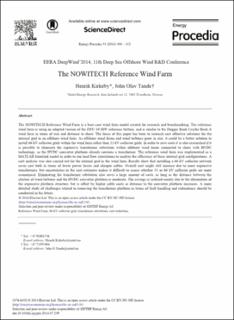| dc.contributor.author | Kirkeby, Henrik | |
| dc.contributor.author | Tande, John Olav Giæver | |
| dc.date.accessioned | 2020-04-17T06:51:23Z | |
| dc.date.available | 2020-04-17T06:51:23Z | |
| dc.date.created | 2014-10-09T12:37:27Z | |
| dc.date.issued | 2014 | |
| dc.identifier.citation | Energy Procedia. 2014, 53 (C), 300-312. | en_US |
| dc.identifier.issn | 1876-6102 | |
| dc.identifier.uri | https://hdl.handle.net/11250/2651400 | |
| dc.description.abstract | The NOWITECH Reference Wind Farm is a base case wind farm model created for research and benchmarking. The reference wind farm is using an adapted version of the DTU 10 MW reference turbine, and is similar to the Dogger Bank Creyke Beck A wind farm in terms of size and distance to shore. The focus of this paper has been to research cost effective solutions for the internal grid in an offshore wind farm. As offshore wind farms and wind turbines grow in size, it could be a better solution to install 66 kV collector grids within the wind farm rather than 33 kV collector grids. In order to save costs it is also researched if it is possible to eliminate the expensive transformer substation within offshore wind farms connected to shore with HVDC technology, as the HVDC converter platform already contains a transformer. The reference wind farm was implemented as a MATLAB Simulink model in order to run load flow simulations to analyze the efficiency of these internal grid configurations. A cost analysis was also carried out for the internal grid in the wind farm. Results show that installing a 66 kV collector network saves cost both in terms of lower power losses and cheaper cables. Overall cost might still increase due to more expensive transformers, but uncertainties in the cost estimates makes it difficult to assess whether 33 or 66 kV collector grids are more economical. Eliminating the transformer substation also saves a large amount of costs, as long as the distance between the clusters of wind turbines and the HVDC converter platform is moderate. The savings is realized mainly due to the elimination of the expensive platform structure, but is offset by higher cable costs as distance to the converter platform increases. A more detailed study of challenges related to removing the transformer platform in terms of fault handling and redundancy should be conducted in the future. | en_US |
| dc.language.iso | eng | en_US |
| dc.rights | Attribution-NonCommercial-NoDerivatives 4.0 Internasjonal | * |
| dc.rights.uri | http://creativecommons.org/licenses/by-nc-nd/4.0/deed.no | * |
| dc.subject | Reference Wind Farm | en_US |
| dc.subject | 66 kV collector grid | en_US |
| dc.subject | transformer substation | en_US |
| dc.subject | cost reduction | en_US |
| dc.title | The NOWITECH Reference Wind Farm | en_US |
| dc.type | Peer reviewed | en_US |
| dc.type | Journal article | en_US |
| dc.description.version | publishedVersion | en_US |
| dc.source.pagenumber | 300-312 | en_US |
| dc.source.volume | 53 | en_US |
| dc.source.journal | Energy Procedia | en_US |
| dc.source.issue | C | en_US |
| dc.identifier.doi | 10.1016/j.egypro.2014.07.239 | |
| dc.identifier.cristin | 1162639 | |
| dc.relation.project | Norges forskningsråd: 193823 | en_US |
| cristin.unitcode | 7548,50,0,0 | |
| cristin.unitname | Energisystemer | |
| cristin.ispublished | true | |
| cristin.fulltext | original | |
| cristin.qualitycode | 1 | |

